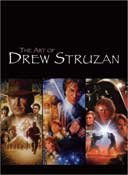Wednesday, September 8, 2010
Despite oil spills, crazy politicians, unemployment and a host of other bad news, this year has been a good one for books on one of my favorite subjects: art. In all its myriad forms and permutations, art thrives, especially in times like these. Here is a smattering of what's new on bookstore shelves in the Art section.
While his name may not be household, anyone who has ever gone to a summer blockbuster is at least passingly familiar with the captivating poster images of Drew Struzan. "Back To The Future," "Raiders of The Lost Ark," "First Blood," "The Goonies," "Risky Business," "Coming To America," "The Thing" and a slew of other films all featured his artwork, and the art is collected in "The Art of Drew Struzan" (Titan Books, 2010, $34.95). There is a reason Steven Spielberg and George Lucas have acquired his services multiple times for their films. Struzan has provided modern-day moviegoers with iconic, resonant images since the mid 1970s and shows no sign of stopping. If you are looking for a little pop culture in your art, some accessible and instantly recognizable imagery awaits you in these pages.
If illustration is your thing, crack open a copy of "Luerzer's Archive Special 200 Best Illustrators Worldwide 2009/2010" (Lurzer GmbH, 2009, $29.50) This expansive collection looks at the work of 200 different illustrators from around the globe. The sheer range of styles and methods on display in this book are inspiring. In a world dominated by stock photography, it's a treat for the eyes to randomly flip the book open and jump from front to back and everywhere in between.
Being a fan of art history doesn't have to be dry and stuffy. Read through Marilyn Stokstad and Michael Cothren's comprehensive art history text "Art History Combined Volume" (Prentice Hall, 2010, $165.95) to find a wealth of information packed into an engaging look at art through the ages. From the earliest cave paintings to current day, the creative efforts of humanity are brought to life in this book. Along with the explanations and motives for various artists, the author also examines the cultural and social context as it relates to the work. Exceptionally illustrated, in-depth and overflowing with knowledge, this may seem expensive, but it is an example of getting what you pay for in the best sense.
"Drawing Lab for Mixed Media Artists" (Quarry Books, 2010, $22.99) by Carla Sonheim features a year's worth of creative exercises and projects designed to lead the non-traditional artist back to the simple joy of drawing. For artists who hate to actually draw, this is the book for you. Loose and relaxed in its instruction, the experiments found in this book take an informal approach to bringing diehard non-drawing artists back into the fold of one of art's most basic and celebrated methods. Even if you already consider yourself a capable or accomplished drawer, there are inspiring and lighthearted assignments within these pages that will move you away from your comfort zone. A terrific book for the beginner or veteran artist.
If your parents never forced you into bad-looking clothes to stand uncomfortably close to one another at a portrait studio, you're lucky. For those of us who endured this suffering, take heart: You are not alone, as evidenced by "Awkward Family Photos" by Mike Bender and Doug Chernack (Three Rivers Press, 2010, $14.95). In an age before the digital camera, people went to highly trained professionals whose job was to bring out the best in your family for one defining moment. Unfortunately, that rarely occurred. Laugh out loud, and you will, at these ridiculously bad family photos, wince at the animosity emanating from siblings' expressions, and hope there aren't a pair of amorous donkeys in the background of that shot.
For the person who doesn't like to read, may I suggest "The Sneaker Coloring Book" (Laurence King Publishing, 2010, $19.95) by Daniel Jarosch and Henrik Klingel, 100 line-art drawings of popular athletic shoes just waiting for you and a box of crayons. Beginning with the Keds Champion from 1916, this mostly wordless book features popular and innovative styles of shoes that run all the way to 2002. If you've ever had any interest in how those kicks on your feet were built, or thought about designing them, then here is a great starting point. So get out that 64-count box of crayons and put the built-in sharpener to good use.

Comments
Use the comment form below to begin a discussion about this content.
Sign in to comment
Or login with:
OpenID